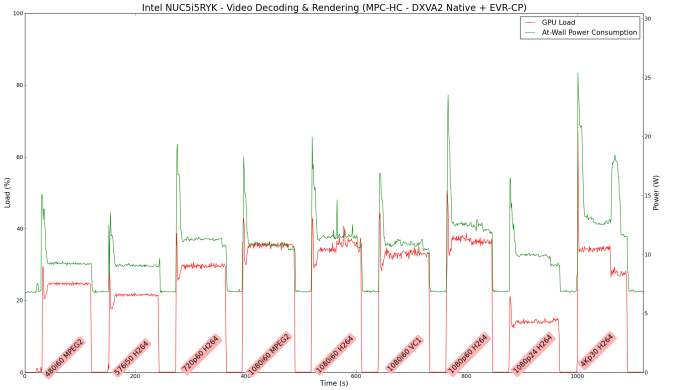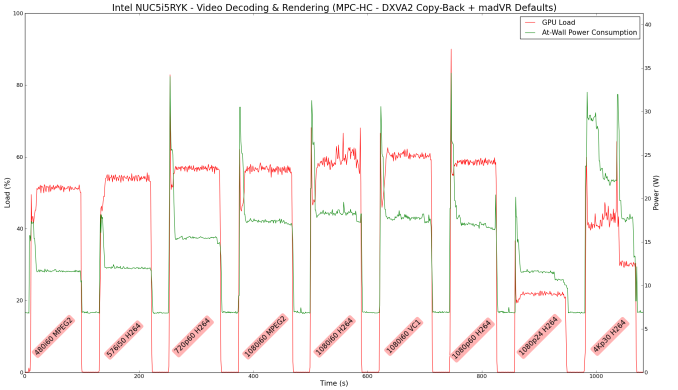Intel NUC5i5RYK Review: A Broadwell-U UCFF PC for Enthusiasts
by Ganesh T S on February 20, 2015 8:00 AM ESTHTPC Credentials
The NUC5i5RYK is a UCFF PC, but, thanks to the 15W TDP CPU inside, it doesn't require a noisy thermal solution. Subjectively speaking, the unit is silent for most common HTPC use-cases. Only under heavy CPU / GPU loading does the fan become audible. In our investigation, recent software improvements in the software chain for playback on Windows have lightened the stress considerably. The NUC5i5RYK definitely makes a good HTPC for folks who don't want to pay the premium for a passively cooled system.
Refresh Rate Accurancy
Starting with Haswell, Intel, AMD and NVIDIA have been on par with respect to display refresh rate accuracy. The most important refresh rate for videophiles is obviously 23.976 Hz (the 23 Hz setting). As expected, the Intel NUC5i5RYK has no trouble with refreshing the display appropriately in this setting.
The gallery below presents some of the other refresh rates that we tested out. The first statistic in madVR's OSD indicates the display refresh rate.
Network Streaming Efficiency
Evaluation of OTT playback efficiency was done by playing back our standard YouTube test stream and five minutes from our standard Netflix test title. Using HTML5, the YouTube stream plays back a 720p encoding. Since YouTube now defaults to HTML5 for video playback, we have stopped evaluating Adobe Flash acceleration. Note that only NVIDIA exposes GPU and VPU loads separately. Both Intel and AMD bundle the decoder load along with the GPU load. The following two graphs show the power consumption at the wall for playback of the HTML5 stream in Mozilla Firefox (v 35.0.1).

GPU load was around 13.46% for the YouTube HTML5 stream and 2.92% for the steady state 6 Mbps Netflix streaming case.
Netflix streaming evaluation was done using the Windows 8.1 Netflix app. Manual stream selection is available (Ctrl-Alt-Shift-S) and debug information / statistics can also be viewed (Ctrl-Alt-Shift-D). Statistics collected for the YouTube streaming experiment were also collected here.

For similar OTT streaming workloads, the NUC5i5RYK unit consumes slightly lower power at the wall compared to the corresponding Haswell NUC. That said, it is difficult to quantify how much of this is due to Broadwell moving down to 14nm. Other components such as the WLAN adapter, DRAM and even the power supply have changed between the two compared units. That said, the Core i5 U-based Broadwell NUC is more power-efficient for these workloads compared to the Core i7 U-based BRIX units.
Decoding and Rendering Benchmarks
In order to evaluate local file playback, we concentrate on EVR-CP and madVR using the mainstream configuration (which has the 1600 MHz DRAM). We already know that EVR works quite well even with the Intel IGP for our test streams. In our Broadwell BRIX s review, we found the HD Graphics 5500 to be incapable of downscaling 4kp30 to 1080p using default madVR settings. We didn't have much hopes for HD Graphics 6000 and our fears were confirmed when similar results were obtained with the NUC5i5RYK initially using the LAV Filters DXVA 2 Copy-Back mode in MPC-HC 1.7.8.
One of the odd aspects that we found in the course of the 4kp30 playback and downscaling process using madVR was that the GPU loading never went above 70%, but approximately half the frames were getting dropped. A careful analysis of the OSD revealed that the split queue was simply not able to keep up (with queues prior to that in the OSD being kept close to full). madVR's split queue copies the decoded frames from the GPU RAM to system RAM and then back to GPU RAM. However, this process seemed to be too slow for 4Kp30 content on the Intel IGP. Just as we were about to wrap up testing of the decoding and rendering aspects, LAV Filters 0.64 was released with huge improvements in DXVA Copy-Back performance. We repeated our benchmarks after overriding the in-built LAV filters of MPC-HC 1.7.8 with LAV Filters 0.64. 4Kp30 downscaling with madVR default settings worked without any dropped frames.
Usually, we suggest usage of the QuickSync decoder built into LAV Video Decoder whenever playback with an Intel IGP machine is desired. However, HEVC decode acceleration using DXVA (implemented partially in software) is available only in the DXVA2N and DXVA2 Copy-Back modes for Broadwell. Hence, we no longer recommend setting the default codec in LAV Video Decoder to Intel QuickSync.
In our earlier reviews, we focused on presenting the GPU loading and power consumption at the wall in a table (with problematic streams in bold). This time around, we decided to represent the GPU load and power consumption in a graph with dual Y-axes. Nine different test streams of 90 seconds each were played back with a gap of 30 seconds between each of them. The characteristics of each stream are annotated at the bottom of the graph. Note that the GPU usage is graphed in red and needs to be considered against the left axis, while the at-wall power consumption is graphed in green and needs to be considered against the right axis.
Points of concern would be GPU loading being consistently above 85 - 90%, but there is no such case in the two scenarios tested above. Power consumption at the wall is less than 15 W for even the most complicated streams when using EVR-CP, while madVR with DXVA2 Copy-Back decoding averages around 20 W for the higher complexity streams involving scaling for fast frame rate or high-resolution content.


















83 Comments
View All Comments
BlueBlazer - Saturday, February 21, 2015 - link
Heck no, used to have AMD E-350 and that sucked. Tried the older Atom 330 also but not well also. The problem was Hi10p which uses software decoding (not supported by hardware). Then switched to using my ancient LGA775 which was collecting dust. Was microATX casing thus certainly quite big but can always hide them in some corner. Only problem was dust accumulation due to the fans (have clean the machine once a while). That's the main problem with fans...Used an old Core 2 Duo E7600 and runs perfectly everything including those that do not use hardware acceleration. Have tried H.265 also (only supported by software decoding on my hardware) and managed to play them up 1080p 30fps with the Lentoid HEVC decoder (possibly the fastest decoder around but does have a compatibility issues with a few files, which I can fallback to VLC Player). Perhaps time for a change, and with H.265 looming around the corner, CPU power could be still relevant after all. If there is a new CPU can beat this old E7600 performance without using fans then I've found the replacement...
BPB - Wednesday, February 25, 2015 - link
My experience is that AMD is better if you are using the HTPC for WMC as well as other things. When I switched from an AMD E450 setup to an i5 setup I lost the abilibity to watch stuff at 1.5 speed. My AMD setup fast-forwarded with sound much, much better than the Intel setup does. The Intel setup is better in every other way, but I really miss watching some games at 1.5X. I like to do that when I don't have the time to watch it at normal speed, or I already know the outcome. The AMD setup allowed me to watch hockey games at 1.5X with sound and no choppiness, the Intel setup is not smooth at all.valnar - Thursday, February 26, 2015 - link
Depends on whether AMD can do perfect 23.976 fps for NTSC stuff. Intel graphics can. Generally, it is safer to use Intel for HTPC's (both Windows and Linux) than AMD.iFX.64 - Saturday, June 20, 2015 - link
Sorry I know I'm a bit late here, but If you want to pass-through DTS HD Master Audio or Dolby TrueHD Master Audio through HDMI to an amp/receiver ... then forget about AMD, I've yet to see anyone get it to work... Unfortunately it only seems to work on Intel :(Of course I only found this out after buying multiple AMD systems for this purpose... believing that they wouldn't say something IS supported in the marketing material when it ISN'T... but while standard 5.1 DTS or Dolby Digital works fine, DTS HD and TrueHD won't pass-through to the receiver.
If anyone has found a way to get it to work, I'd LOVE to hear about it ;)
Veritex - Friday, February 20, 2015 - link
A good solution is arriving in around 90 days in the form of the AMD Carrizo and Carrizo-L (10w to 35w) APUs with upgraded Excavator cores, next gen full HSA GPU and hardware encode/decode of h.265 4k video. They will be available in everything from laptops to all-in-ones and in micro/pico/ITX systems.Anandtech had a preview at CES 2015:
"One of the features of Carrizo is full support for H.265 decoding, and as an example of why this is needed they had an Intel system running next to the Carrizo system attempting to playback a 4K H.265 video. While the AMD system was easily able to handle the task without dropping any frames, the Intel system was decoding at what appeared to be single digit frame rates. The 4K content was essentially unwatchable on Intel."
http://www.anandtech.com/show/8855/amd-demonstrate...
BlueBlazer - Saturday, February 21, 2015 - link
That Core i3 was of the older generation (not Broadwell), and of course would be less powerful to perform software decoding for 4K video. If they had used a Core i7 quad core then should be able to playback 4K video smoothly even through software decoding. Also does not mention if Carrizo can support VP8 or 10-bit H.265/HEVC either...Additionally Intel Broadwell and even Haswell already have a hybrid H.265/HEVC decoder (uses both CPU and GPU) in the latest drivers: http://techreport.com/news/27677/new-intel-igp-dri... Besides H.265/HEVC, it also supports VP9 codec (used by Google TV). Futhermore it can also support 10-bit H.265/HEVC format besides the normal 8-bit H.265/HEVC. Wished that it would also support the old 10-bit H.264 (also known as Hi10p) as well...
BlueBlazer - Saturday, February 21, 2015 - link
Errata: VP9 in the first paragraph and not VP8..."Also does not mention if Carrizo can support VP8 or 10-bit H.265/HEVC either..."
Vinny DePaul - Saturday, February 21, 2015 - link
Why do people rip blu ray to NAS? Is it legal? I don't understand why people store so many movies on their PC. Can you watch that much? Also, is it even legal?TheinsanegamerN - Saturday, February 21, 2015 - link
Why do we rip movies? so that way if something happens to the disk, i still have my movie, and I dont need to find the dvd and put it into the player to watch a movie, i can just double click it.And of course it is legal. Im making a backup of my own copy, and im not sharing it.
kmmatney - Sunday, February 22, 2015 - link
I rip movies (redbox rentals) so I can watch it at a convenient time, on whatever device I want. It's rare I watch anything more than once. Lately I've been renting more movies on demand, though, as long as the price is reasonable